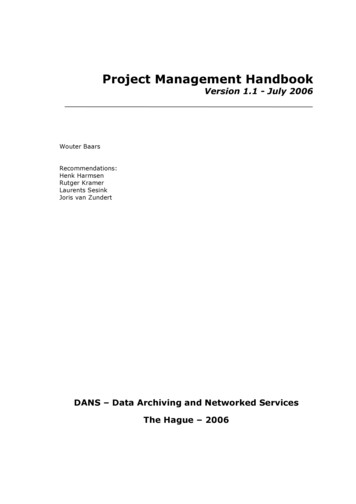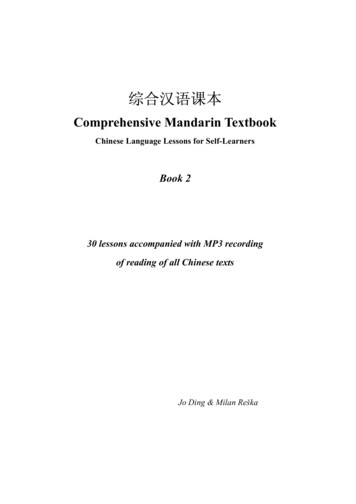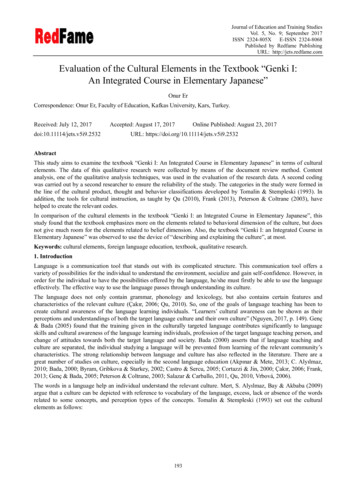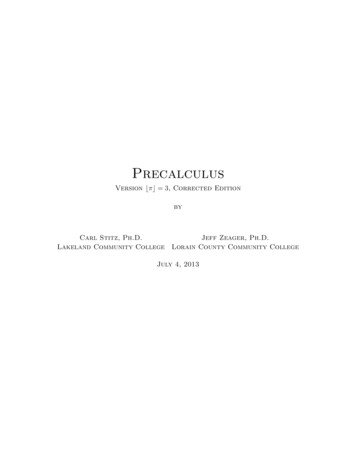
Transcription
Streamlet: Textbook Streamlined BlockchainsBenjamin Y Chan1 and Elaine Shi21Cornell University - byc@cs.cornell.edu2CMU/Cornell - runting@gmail.comSeptember 12, 2020AbstractIn the past five years or so, numerous blockchain projects have made tremendous progresstowards improving permissioned consensus protocols (partly due to their promised applicationsin Proof-of-Stake cryptocurrencies). Although a significant leap has silently taken place in ourunderstanding of consensus protocols, it is rather difficult to navigate this body of work, andknowledge of the new techniques appears scattered.In this paper, we describe an extremely simple and natural paradigm called Streamlet forconstructing consensus protocols. Our protocols are inspired by the core techniques that havebeen uncovered in the past five years of work; but to the best of our knowledge our embodimentis simpler than ever before and we accomplish this by taking a “streamlining” idea to its fullpotential. We hope that our textbook constructions will help to decipher the past five yearsof work on consensus partly driven by the cryptocurrency community — in particular, howremarkably simple the new generation of consensus protocols has become in comparison withclassical mainstream approaches such as PBFT and Paxos.1
1IntroductionDistributed consensus allows a set of players to agree on an ever-growing, linearly ordered log oftransactions. For over a decade, companies like Google and Facebook have deployed consensus aspart of their core infrastructure, to replicate mission-critical services such as Google Wallet andFacebook Credit. Consensus is also the core abstraction behind modern cryptocurrency systemssuch as Bitcoin and Ethereum. Since transactions are typically batched into “blocks” duringconsensus, we also refer to such protocols as blockchain protocols. The name “blockchain” gainedpopularity with Bitcoin. Before Bitcoin, such consensus protocols were commonly referred to asState Machine Replication protocols [3, 14, 24].As we all know, by leveraging Proof-of-Work (PoW), Bitcoin’s Nakamoto consensus [9,19,21,23]was the first to achieve consensus in a “permissionless” environment where everyone can join as aparticipant. However, partly due to the enormous energy waste of PoW, the community has beenpushing for a new paradigm called Proof-of-Stake (PoS), where, roughly speaking, players havevoting power proportional to their stake (i.e., in terms of cryptocurrencies owned) in the system.Interesting, as many works have shown [6, 7, 12], PoS systems actually return to the classical rootsof consensus, that is, they rely instead on “permissioned” consensus as a core building block. Inessence, these PoS systems typically employ a committee reconfiguration mechanism to rotate theconsensus participants over time based on the latest stake distribution; and at any snapshot intime, the elected participants run a permissioned consensus protocol. This paradigm shift towardsPoS rekindled the community’s interest in classical, permissioned consensus.In this paper, we focus on how to construct a simple, permissioned consensus protocol calledStreamlet. Streamlet realizes the same abstraction as classical landmark protocols such asPBFT [3] and Paxos [14] — however, unlike the classical counterparts, Streamlet is absurdlysimple, making it a perfect choice for pedagogy. Considering several decades of work that aimedto simplify the PBFT/Paxos family of protocols (notably, RAFT [20] and other efforts [17, 27]), itmight be somewhat surprising at first that such a remarkably simple and natural protocol turnsout to be possible.1.1Streamlet in a Nutshell and Our ContributionsIt is perhaps most instructive to present the protocol upfront. Let us briefly recall the setting:there are n players participating in the consensus protocol, and their public keys are well-known(i.e., the classical “permissioned” setting). We assume that strictly fewer than n/3 players can becorrupt, and corrupt players can deviate from the prescribed protocol arbitrarily and maliciously.We assume that players have synchronized clocks1 and that the protocol proceeds in synchronizedepochs, each of which is, say, 1 second long (the “1 second” parameter can be replaced with otherreasonable choices and we shall discuss how to choose this parameter shortly). Although we assumesynchronized clocks, the protocol achieves consistency (i.e., safety) regardless of how long themessage delays are or how badly the network might be partitioned.1It is well-known that in a partially synchronous network, as long as players have clocks with bounded drift, it ispossible to employ a simple clock synchronization procedure to establish a synchronized clock [8]. In this work, forsimplicity, we assume synchronized clocks. The clock synchrony will only be needed for our liveness proof but notconsistency.1
epochepochepochepoch2567epochepochepoch13XFigure 1: Streamlet finalization example. In this example, the prefix of the top chain up tothe epoch-6 block is considered final.The protocol. In Streamlet, each epoch has a designated leader chosen at random by apublicly known hash function. We assume that a valid blockchain is a sequence of blocks cryptographically “chained” together by a hash function, i.e., each block contains a hash of its prefix.Now, the Streamlet protocol works as follows: Propose-Vote. In every epoch:– The epoch’s designated leader proposes a new block extending from the longest notarized chainit has seen (if there are multiple, break ties arbitrarily). The notion “notarized” is definedbelow.– Every player votes for the first proposal they see from the epoch’s leader, as long as theproposed block extends from (one of) the longest notarized chain(s) that the voter has seen.A vote is a signature on the proposed block.– When a block gains votes from at least 2n/3 distinct players, it becomes notarized. A chain isnotarized if its constituent blocks are all notarized. Finalize. Notarized does not mean final. If in any notarized chain, there are three adjacentblocks with consecutive epoch numbers, the prefix of the chain up to the second of the threeblocks is considered final. When a block becomes final, all of its prefix must be final too.Importantly, the entire protocol follows a unified propose-vote paradigm, making it very naturaland leaving (seemingly) no room for misinterpretation. In comparison, the classical mainstreamapproach [3, 10, 13, 14, 18, 18, 20] typically adopts a simple fast path that follows a “propose-vote”paradigm, but the fast path provides no liveness in the face of faults. To achieve liveness in thepresence of faulty nodes, classical mainstream approaches resort to an additional, often complicated/subtle recovery path (see Section 1.2 for more discussion).How does Streamlet achieve both consistency and liveness with a unified propose-vote paradigm?The somewhat cute finalization rule is part of the “magic”. An example of applying the finalizationrule is shown in Figure 1. In this example, imagine all blocks are notarized: we see that there is anotarized chain with 3 adjacent blocks having consecutive epoch numbers 5, 6, and 7. Therefore,the entire prefix of the chain up to and including the epoch-6 block is considered final (i.e., alltransactions contained in these blocks are confirmed and cannot be undone).We shall prove later that in this case, there cannot be another conflicting block X notarizedat the same length (i.e., position in the blockchain, or distance from the ‘genesis block’) as theepoch-6 block, and thus consistency is achieved. We now state the protocol’s provable guarantees(slightly informally at this point).2
Provable guarantees. In the remainder of the paper, we will describe the Streamlet protocolslightly more formally, and prove that this extremely simple protocol1. achieves consistency no matter what the actual network delays are, even if the network ispartitioned at times;2. achieves liveness with expected constant confirmation delay when network conditions are good,i.e., during a period of time in which honest nodes can send messages back and forth to eachother within a 1-second round-trip time.The conditions under which liveness holds are often referred to as a period of synchrony [8].Obviously, if the network is partitioned and nodes cannot deliver messages to each other, theprotocol cannot make progress. The Streamlet protocol guarantees consistency nonetheless, nomatter how bad or adversarial the network conditions are. In the literature, protocols satisfyingsuch properties are often said to be partially synchronous [8] and partition tolerant. It is wellknown that partially synchronous protocols cannot tolerate 1/3 or more corruptions [8] and thusthe protocol described above achieves optimal resilience.How do we set the epoch length? The epoch length is typically set to be an estimate of themessage round-trip time under normal/good network conditions.Variants.With very minor tweaks, we obtain a couple variants: An honest-majority, synchronous variant. With a couple minor tweaks, we obtain a newprotocol and prove it secure under honest majority in a synchronous network — note thatdue to the 1/3 partially synchronous lower bound [8], network synchrony assumptions areindeed necessary for resisting minority corruptions.The tweaks include 1) requiring n/2 signatures for notarization; 2) looking for 6 consecutiveepochs in a notarized chain and chopping off 5 for finalization2 ; furthermore, at finalizationtime, checking to make sure that the 6 blocks at consecutive epochs do not have conflictingnotarizations at the same lengths. A crash-fault tolerant, honest majority variant. Taking the protocol above, changing thenotarization threshold to n/2 and removing the use of signatures, would give a crash-faulttolerant version secure under honest majority. This variant is also perfect for pedagogy: onecan teach it without introducing digital signatures.1.2Comparison with Prior ApproachesClassical mainstream protocols: simple fast path complicated recovery. Classicalmainstream approaches such as PBFT [3], Paxos [14], and their numerous variants [10, 13, 18, 20],adopt a bi-modal approach: the protocol typically consists of a simple normal path where a leadermakes proposals and everyone votes; and when the normal path fails, the protocol switches to a(typically much more complicated) fall-back mode typically called a “view change” [3]. From atechnical perspective, the normal path promises only consistency and offers no liveness if the leader2These constants can be reduced at the expense of introducing a couple more instructions to the protocol description; our goal in this paper is not to make these constants the smallest possible, but to make the protocol descriptionas simple as possible. In Section 4, we will briefly discuss how one can make these constants smaller.3
is corrupt; whereas the view change protocol must essentially embed a “full-fledged” consensus subprotocol that offers both consistency and liveness. As such, the complexity of classical protocolssuch as PBFT and Paxos arises due to the view change.For decades, researchers have made it a top priority to simplify these consensus protocols, andvarious attempts have been made [15, 20, 27].Recent wave of work motivated by decentralized blockchains. Very recently, due to interest in decentralized cryptocurrencies, various blockchain projects made independent efforts tosimplify consensus protocols [2,4,5,11,25,28]. As mentioned, more recently, the community’s focushas been on permissioned consensus protocols due to the paradigm shift towards Proof-of-Stake.This line of work is known to be difficult to navigate partly due to the use of disparate terminology.Streamlet draws inspiration from many protocols [2, 4, 5, 26, 28] that came out during this wave.For example, our finalization rule is inspired by Casper [2], Hotstuff [28], Pili [5], and Pala [4].Although the simplicity of the Streamlet protocol makes it kind of trivial and obvious inhindsight, it took the community several years of effort and multiple iterations to eventually stripthe protocol down to its current form. Therefore we hope that the simplicity and the multipleiterations of efforts do not detract from our contribution.Most closely related work. The closest related work is the very recent work by Shi [26]. Theirwork, which is in turn inspired by others’ [2, 4, 5, 28], is an important step towards the same goal,i.e., to have a unified, simple protocol for both teaching and implementation. The main differencebetween our protocol and theirs is the following: in their protocol, blocks in a valid blockchain havean additional property called freshness. A block’s freshness is determined by the epoch in which itis notarized. In Shi’s protocol [26], a voter has to compare a proposed block against the freshestnotarized chain seen at the beginning of the previous epoch, to determine whether it is okay to voteon the block. In private communication with the author, we learned that this protocol rule hascaused confusion during lectures and also for engineers who implemented a protocol [4] similar toShi’s proposal [26].Streamlet completely eliminates the freshness notion, and voters simply compare the proposedblock with the longest notarized chain(s) that it has seen at the time of voting — a change thatalso simplifies the consistency proof.Sequential composition of single-shot consensus. Finally, Byzantine Agreement or Byzantine Broadcast [16] is a single-shot consensus abstraction often studied in the theoretical literature.An alternative for constructing a blockchain is through sequential/parallel composition of singleshot consensus. However, cross-instance pipelining is difficult to accomplish in practice. Partly dueto this reason, to the best of our knowledge, most practically deployed schemes employ the “direct blockchain construction” approach. Typically, in a directly constructed blockchain, the entireprotocol is streamlined and there is no clear-cut boundary between single-shot instances. Directlyconstructed blockchains are often easier to optimize in practice.Streamlet is a directly constructed blockchain, and we take the streamlining idea to itsextreme, such that the entire protocol is a streamlined, unified path of “propose-vote” actions.Non-goals. We are aware that some earlier works have strived to minimize the confirmation delay,e.g., Sync-Hotstuff [1]. We stress that minimizing the concrete constants related to confirmation4
delay is not a goal of our paper. In this paper, we instead take simplicity and understandabilityto be first-class principles. Having said this, we briefly discuss in Section 4 how to reduce theconstants by introducing just a couple extra instructions to the Streamlet protocol.In this paper, we focus on static security. We refer the reader to existing works [4, 7] thatpresent somewhat generic approaches for upgrading from static security to adaptive security ormildly adaptive security [22], e.g., in a Proof-of-Stake context.2Execution Model and DefinitionsExecution model. Let us briefly define the execution model. There are in total n nodes numbered 1, 2, . . . , n respectively, and let [n] : {1, 2, . . . , n}. All nodes have a public key that iscommon knowledge. Each node retains its own secret key for signing messages.The adversary may control a subset of the nodes which are said to be corrupt, and the remaining nodes not under adversarial control are honest. Honest nodes always faithfully follow theprescribed protocol but corrupt nodes can deviate from the prescribed protocol arbitrarily (oftencalled Byzantine faults). We assume that the adversary chooses which nodes to corrupt prior tothe execution, i.e., we consider the static corruption model.A protocol’s execution proceeds in rounds, which we use to denote a basic unit of time. Theadversary can arbitrarily delay messages sent by honest nodes. We require “periods of synchrony”for liveness, modeling them using the standard Global Stabilization Time (GST) approach [8].Roughly speaking, before the GST, message delays can be arbitrary; however, after GST, messagessent by honest nodes are guaranteed to be received by honest recipients within number of rounds.More precisely, we assume the following: -bounded assumption during periods of synchrony: When an honest node sends a message in round r, an honest recipient is guaranteed to receive it by the beginning of roundmax(GST, r ).Definition of a blockchain protocol. Nodes participating in a blockchain protocol receiveinputs (e.g. transactions) from an external environment. The nodes are tasked with maintainingan ordered log, called a blockchain, containing a sequence of strings called blocks (note that ablockchain protocol is allowed to define additional validity rules for its blockchain data structure).At any point of time, a node’s output is the blockchain it maintains. Henceforth if a node p outputssome blockchain ch at some time, we also say that p considers ch final, or that ch is the finalizedchain for node p.Without loss of generality, we may assume that the protocol guarantees that a node p’s outputchain never decreases in length — given any protocol Π in which a node p’s output chain maydecrease in length, we can always compile it to a modified protocol Π0 in which if any node p’soutput is ever going to shrink in length in Π, p would simply stick to the present, longer output.We require that a blockchain protocol satisfies consistency and liveness as defined below withall but negligible (in some security parameter) probability over the choice of the random execution. Consistency. If two blockchains ch and ch0 are ever considered final by two honest nodes, itmust be that either ch ch0 or ch0 ch where “ ” means “is a prefix of or equal to”. Liveness. If some honest node receives some input txs in round r, txs will eventually beincluded in all honest nodes’ finalized chains.5
3The Streamlet Protocol: Partially SynchronousIn this section, we present our protocol formally and prove its correctness.3.1Epoch and Leader RotationEpochs: The protocol runs sequentially in synchronized epochs that are each 2 long. Recallthat the parameter determines when a period of synchrony occurs. During a period of synchrony,honest nodes can communicate with each other in at most rounds.Epoch leader: Every epoch e is mapped to a random leader using a public hash function H :{0, 1} [n] which is modeled as a random oracle. Specifically, epoch e’s leader is computed asH(e).3.2Blocks and BlockchainBlock:Each block is a tuple of the form (h, e, txs) where h is called the parent hash, i.e., a hash of the prefix of the chain; e is called the epoch number of the block, which records the epoch in which the block is proposedand voted on; and tx is a payload string (e.g., it may record a set of transactions to be confirmed).A special block of the form ( , e 0, ) is called the genesis block which is the first block ofevery valid blockchain.Blockchain: A blockchain chain is a sequence of blocks starting with the genesis block chain[0] : ( , e 0, ), and with strictly increasing epoch numbers. Throughout we use chain[ ] to refer tothe th block in chain, and chain[: ] to refer to the prefix of chain ending at (and including) theblock chain[ ].For a blockchain chain to be valid, it must be that for every non-genesis block chain[ ] where 0, chain[ ] contains a parent hash equal to H (chain[: 1]), where H denotes a hash functionthat was chosen from a collision-resistant hash family during a setup phase.In a valid blockchain, we often say that a block chain[ ] extends from the parent chain chain[: 1]. Moreover, the block chain[ ] is also said to have length , where is its ‘distance’ from thegenesis block. The chain itself is also said to have a length, equivalent to the number of blocks inchain e
PoS rekindled the community’s interest in classical, permissioned consensus. In this paper, we focus on how to construct a simple, permissioned consensus protocol called Streamlet. Streamlet realizes the same abstraction as classical landmark protocols such as PBFT [3] and Paxos [14] how











